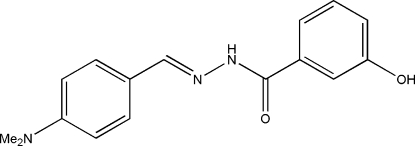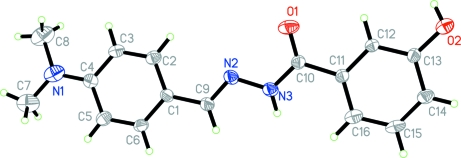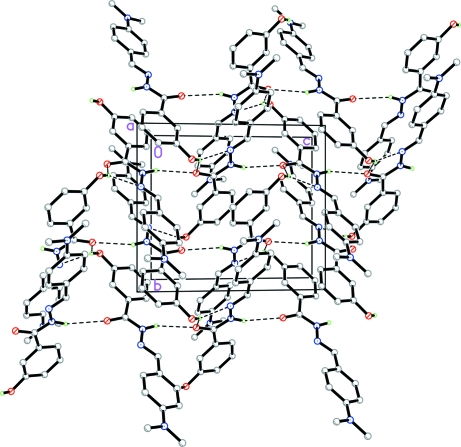Abstract
The title compound, C16H17N3O2, was synthesized by the reaction of 4-dimethylaminobenzaldehyde with 3-hydroxybenzoic acid hydrazide in methanol. The dihedral angle between the two benzene rings in the molecule is 9.2 (2)°. In the crystal structure, molecules are linked through intermolecular O—H⋯O, O—H⋯N and N—H⋯O hydrogen bonds, forming layers parallel to the bc plane.
Related literature
For related literature, see: Akitsu & Einaga (2006 ▶); Bahner et al. (1968 ▶); Butcher et al. (2005 ▶); Hodnett & Mooney (1970 ▶); Merchant & Chothia (1970 ▶); Pradeep (2005 ▶); Sigman & Jacobsen (1998 ▶).
Experimental
Crystal data
C16H17N3O2
M r = 283.33
Monoclinic,

a = 13.397 (3) Å
b = 9.663 (2) Å
c = 11.183 (2) Å
β = 101.97 (3)°
V = 1416.2 (5) Å3
Z = 4
Mo Kα radiation
μ = 0.09 mm−1
T = 298 (2) K
0.28 × 0.27 × 0.27 mm
Data collection
Bruker SMART APEX area-detector diffractometer
Absorption correction: multi-scan (SADABS; Sheldrick, 1996 ▶) T min = 0.975, T max = 0.976
11531 measured reflections
3094 independent reflections
2579 reflections with I > 2σ(I)
R int = 0.021
Refinement
R[F 2 > 2σ(F 2)] = 0.044
wR(F 2) = 0.130
S = 1.05
3094 reflections
196 parameters
1 restraint
H atoms treated by a mixture of independent and constrained refinement
Δρmax = 0.21 e Å−3
Δρmin = −0.29 e Å−3
Data collection: SMART (Siemens, 1996 ▶); cell refinement: SAINT (Siemens, 1996 ▶); data reduction: SAINT; program(s) used to solve structure: SHELXS97 (Sheldrick, 2008 ▶); program(s) used to refine structure: SHELXL97 (Sheldrick, 2008 ▶); molecular graphics: SHELXTL (Sheldrick, 2008 ▶); software used to prepare material for publication: SHELXL97.
Supplementary Material
Crystal structure: contains datablocks global, I. DOI: 10.1107/S160053680800130X/su2040sup1.cif
Structure factors: contains datablocks I. DOI: 10.1107/S160053680800130X/su2040Isup2.hkl
Additional supplementary materials: crystallographic information; 3D view; checkCIF report
Table 1. Hydrogen-bond geometry (Å, °).
| D—H⋯A | D—H | H⋯A | D⋯A | D—H⋯A |
|---|---|---|---|---|
| O2—H2⋯O1i | 0.82 | 2.18 | 2.8470 (14) | 138 |
| O2—H2⋯N2i | 0.82 | 2.36 | 3.1008 (16) | 150 |
| N3—H3A⋯O1ii | 0.895 (9) | 2.561 (11) | 3.4172 (16) | 160.4 (16) |
Symmetry codes: (i)  ; (ii)
; (ii)  .
.
supplementary crystallographic information
Comment
Schiff base compounds have been widely investigated due to their easy synthesis, versatile structures and wide applications (Sigman & Jacobsen, 1998; Akitsu & Einaga, 2006; Pradeep, 2005; Butcher et al., 2005). The excellent antibacterial and antitumor properties of such compounds have attracted much interest in recent years (Hodnett & Mooney, 1970; Bahner et al., 1968; Merchant & Chothia, 1970). In order to investigate further the structures of such compounds, the new title Schiff base compound is reported on here.
The dihedral angle between the two benzene rings in the molecule (Fig. 1) of the title compound is 9.2 (2)°. In the crystal structure, molecules are linked through intermolecular O–H···O, O–H···N and N–H···O hydrogen bonds (Table 1), forming layers parallel to the bc plane (Fig. 2).
Experimental
The title compound was obtained by stirring of 4-dimethylaminobenzaldehyde (0.1 mmol, 14.9 mg) and 3-hydroxybenzoic acid hydrazide (0.1 mmol, 15.2 mg) in a methanol solution (10 ml) at room temperature. Yellow block-shaped single crystals suitable for X-ray diffraction were formed from the solution after seven days.
Refinement
H3A was located from a difference Fourier map and refined with the N–H distance restrained to 0.90 (1) Å, and Uiso(H) = 0.08 Å2. Other H atoms were positioned geometrically (C–H = 0.93–0.96Å and O–H = 0.82 Å) and treated as riding atoms, with Uiso(H) = 1.2Ueq(C) and 1.5Ueq(O and methyl-C).
Figures
Fig. 1.
The molecular structure of the title compound, showing the atom labelling scheme and displacement ellipsoids drawn at the 30% probability level.
Fig. 2.
Crystal packing of the title compound view along the a axis [hydrogen bonds are drawn as dotted lines].
Crystal data
| C16H17N3O2 | F000 = 600 |
| Mr = 283.33 | Dx = 1.329 Mg m−3 |
| Monoclinic, P21/c | Mo Kα radiation λ = 0.71073 Å |
| Hall symbol: -P 2ybc | Cell parameters from 4593 reflections |
| a = 13.397 (3) Å | θ = 2.5–27.7º |
| b = 9.663 (2) Å | µ = 0.09 mm−1 |
| c = 11.183 (2) Å | T = 298 (2) K |
| β = 101.97 (3)º | Block, yellow |
| V = 1416.2 (5) Å3 | 0.28 × 0.27 × 0.27 mm |
| Z = 4 |
Data collection
| Bruker SMART APEX area-detector diffractometer | 3094 independent reflections |
| Radiation source: fine-focus sealed tube | 2579 reflections with I > 2σ(I) |
| Monochromator: graphite | Rint = 0.021 |
| T = 298(2) K | θmax = 27.0º |
| ω scans | θmin = 2.6º |
| Absorption correction: multi-scan(SADABS; Sheldrick, 1996) | h = −16→17 |
| Tmin = 0.975, Tmax = 0.976 | k = −12→12 |
| 11531 measured reflections | l = −14→14 |
Refinement
| Refinement on F2 | Secondary atom site location: difference Fourier map |
| Least-squares matrix: full | Hydrogen site location: inferred from neighbouring sites |
| R[F2 > 2σ(F2)] = 0.044 | H atoms treated by a mixture of independent and constrained refinement |
| wR(F2) = 0.130 | w = 1/[σ2(Fo2) + (0.0773P)2 + 0.1729P] where P = (Fo2 + 2Fc2)/3 |
| S = 1.05 | (Δ/σ)max < 0.001 |
| 3094 reflections | Δρmax = 0.21 e Å−3 |
| 196 parameters | Δρmin = −0.29 e Å−3 |
| 1 restraint | Extinction correction: none |
| Primary atom site location: structure-invariant direct methods |
Special details
| Geometry. All e.s.d.'s (except the e.s.d. in the dihedral angle between two l.s. planes) are estimated using the full covariance matrix. The cell e.s.d.'s are taken into account individually in the estimation of e.s.d.'s in distances, angles and torsion angles; correlations between e.s.d.'s in cell parameters are only used when they are defined by crystal symmetry. An approximate (isotropic) treatment of cell e.s.d.'s is used for estimating e.s.d.'s involving l.s. planes. |
| Refinement. Refinement of F2 against ALL reflections. The weighted R-factor wR and goodness of fit S are based on F2, conventional R-factors R are based on F, with F set to zero for negative F2. The threshold expression of F2 > σ(F2) is used only for calculating R-factors(gt) etc. and is not relevant to the choice of reflections for refinement. R-factors based on F2 are statistically about twice as large as those based on F, and R- factors based on ALL data will be even larger. |
Fractional atomic coordinates and isotropic or equivalent isotropic displacement parameters (Å2)
| x | y | z | Uiso*/Ueq | ||
| O1 | 0.51231 (8) | 0.27675 (11) | 0.29293 (9) | 0.0574 (3) | |
| O2 | 0.28657 (7) | 0.69755 (10) | 0.22473 (9) | 0.0486 (3) | |
| H2 | 0.3315 | 0.7006 | 0.1849 | 0.073* | |
| N1 | 0.97117 (10) | −0.30631 (15) | 0.63913 (13) | 0.0654 (4) | |
| N2 | 0.60441 (8) | 0.13189 (10) | 0.48763 (10) | 0.0416 (3) | |
| N3 | 0.52359 (8) | 0.22033 (11) | 0.49046 (10) | 0.0420 (3) | |
| C1 | 0.72192 (9) | −0.03254 (12) | 0.59700 (11) | 0.0379 (3) | |
| C2 | 0.78863 (10) | −0.03161 (13) | 0.51647 (11) | 0.0430 (3) | |
| H2A | 0.7774 | 0.0302 | 0.4513 | 0.052* | |
| C3 | 0.87041 (10) | −0.11981 (14) | 0.53134 (12) | 0.0445 (3) | |
| H3 | 0.9138 | −0.1157 | 0.4764 | 0.053* | |
| C4 | 0.89036 (9) | −0.21613 (13) | 0.62715 (12) | 0.0425 (3) | |
| C5 | 0.82405 (10) | −0.21577 (14) | 0.70911 (12) | 0.0456 (3) | |
| H5 | 0.8352 | −0.2770 | 0.7747 | 0.055* | |
| C6 | 0.74284 (10) | −0.12595 (14) | 0.69358 (11) | 0.0424 (3) | |
| H6 | 0.7004 | −0.1277 | 0.7496 | 0.051* | |
| C7 | 0.99119 (16) | −0.4061 (2) | 0.73523 (17) | 0.0793 (6) | |
| H7A | 1.0129 | −0.3597 | 0.8121 | 0.119* | |
| H7B | 1.0439 | −0.4679 | 0.7219 | 0.119* | |
| H7C | 0.9302 | −0.4578 | 0.7363 | 0.119* | |
| C8 | 1.04154 (15) | −0.2992 (2) | 0.5584 (2) | 0.0903 (7) | |
| H8A | 1.0063 | −0.3194 | 0.4764 | 0.135* | |
| H8B | 1.0952 | −0.3655 | 0.5835 | 0.135* | |
| H8C | 1.0702 | −0.2079 | 0.5612 | 0.135* | |
| C9 | 0.63422 (9) | 0.05897 (13) | 0.58348 (11) | 0.0411 (3) | |
| H9 | 0.5988 | 0.0645 | 0.6466 | 0.049* | |
| C10 | 0.48449 (9) | 0.29458 (12) | 0.38962 (12) | 0.0397 (3) | |
| C11 | 0.40510 (9) | 0.39961 (12) | 0.40150 (11) | 0.0375 (3) | |
| C12 | 0.38258 (9) | 0.49733 (12) | 0.30887 (11) | 0.0375 (3) | |
| H12 | 0.4168 | 0.4954 | 0.2446 | 0.045* | |
| C13 | 0.30939 (9) | 0.59770 (12) | 0.31174 (11) | 0.0380 (3) | |
| C14 | 0.25681 (10) | 0.59887 (14) | 0.40629 (12) | 0.0453 (3) | |
| H14 | 0.2067 | 0.6651 | 0.4080 | 0.054* | |
| C15 | 0.27927 (11) | 0.50121 (16) | 0.49776 (13) | 0.0530 (4) | |
| H15 | 0.2440 | 0.5021 | 0.5611 | 0.064* | |
| C16 | 0.35350 (10) | 0.40181 (14) | 0.49689 (12) | 0.0469 (3) | |
| H16 | 0.3686 | 0.3372 | 0.5596 | 0.056* | |
| H3A | 0.5095 (14) | 0.2388 (19) | 0.5637 (11) | 0.080* |
Atomic displacement parameters (Å2)
| U11 | U22 | U33 | U12 | U13 | U23 | |
| O1 | 0.0646 (6) | 0.0592 (6) | 0.0572 (6) | 0.0197 (5) | 0.0327 (5) | 0.0044 (5) |
| O2 | 0.0480 (5) | 0.0487 (5) | 0.0530 (6) | 0.0081 (4) | 0.0192 (4) | 0.0094 (4) |
| N1 | 0.0552 (7) | 0.0751 (9) | 0.0698 (8) | 0.0289 (7) | 0.0219 (6) | 0.0220 (7) |
| N2 | 0.0369 (5) | 0.0388 (6) | 0.0501 (6) | 0.0050 (4) | 0.0114 (4) | −0.0082 (4) |
| N3 | 0.0380 (5) | 0.0417 (6) | 0.0485 (6) | 0.0072 (4) | 0.0137 (5) | −0.0065 (5) |
| C1 | 0.0368 (6) | 0.0382 (6) | 0.0391 (6) | −0.0001 (5) | 0.0087 (5) | −0.0057 (5) |
| C2 | 0.0452 (7) | 0.0451 (7) | 0.0400 (6) | 0.0056 (5) | 0.0115 (5) | 0.0069 (5) |
| C3 | 0.0427 (7) | 0.0535 (8) | 0.0407 (7) | 0.0056 (5) | 0.0162 (5) | 0.0024 (5) |
| C4 | 0.0388 (6) | 0.0447 (7) | 0.0432 (7) | 0.0046 (5) | 0.0067 (5) | 0.0001 (5) |
| C5 | 0.0467 (7) | 0.0504 (7) | 0.0397 (7) | 0.0023 (6) | 0.0085 (5) | 0.0086 (5) |
| C6 | 0.0428 (7) | 0.0499 (7) | 0.0373 (6) | −0.0026 (5) | 0.0149 (5) | −0.0027 (5) |
| C7 | 0.0834 (12) | 0.0834 (13) | 0.0713 (11) | 0.0421 (10) | 0.0162 (9) | 0.0196 (9) |
| C8 | 0.0656 (11) | 0.1028 (15) | 0.1139 (16) | 0.0410 (11) | 0.0449 (11) | 0.0305 (13) |
| C9 | 0.0394 (6) | 0.0403 (6) | 0.0456 (7) | 0.0004 (5) | 0.0131 (5) | −0.0074 (5) |
| C10 | 0.0359 (6) | 0.0369 (6) | 0.0497 (7) | 0.0000 (5) | 0.0165 (5) | −0.0046 (5) |
| C11 | 0.0332 (6) | 0.0371 (6) | 0.0442 (7) | −0.0012 (5) | 0.0122 (5) | −0.0055 (5) |
| C12 | 0.0352 (6) | 0.0394 (6) | 0.0412 (6) | −0.0024 (5) | 0.0156 (5) | −0.0044 (5) |
| C13 | 0.0345 (6) | 0.0378 (6) | 0.0423 (6) | −0.0024 (5) | 0.0095 (5) | −0.0018 (5) |
| C14 | 0.0393 (6) | 0.0472 (7) | 0.0530 (7) | 0.0094 (5) | 0.0182 (5) | −0.0002 (6) |
| C15 | 0.0532 (8) | 0.0630 (9) | 0.0511 (8) | 0.0150 (6) | 0.0302 (6) | 0.0071 (6) |
| C16 | 0.0486 (7) | 0.0502 (7) | 0.0464 (7) | 0.0102 (6) | 0.0199 (6) | 0.0079 (6) |
Geometric parameters (Å, °)
| O1—C10 | 1.2267 (15) | C6—H6 | 0.9300 |
| O2—C13 | 1.3593 (15) | C7—H7A | 0.9600 |
| O2—H2 | 0.8200 | C7—H7B | 0.9600 |
| N1—C4 | 1.3745 (17) | C7—H7C | 0.9600 |
| N1—C7 | 1.427 (2) | C8—H8A | 0.9600 |
| N1—C8 | 1.436 (2) | C8—H8B | 0.9600 |
| N2—C9 | 1.2757 (16) | C8—H8C | 0.9600 |
| N2—N3 | 1.3848 (14) | C9—H9 | 0.9300 |
| N3—C10 | 1.3475 (17) | C10—C11 | 1.4958 (16) |
| N3—H3A | 0.895 (9) | C11—C16 | 1.3864 (18) |
| C1—C6 | 1.3907 (17) | C11—C12 | 1.3878 (17) |
| C1—C2 | 1.3942 (17) | C12—C13 | 1.3842 (17) |
| C1—C9 | 1.4531 (17) | C12—H12 | 0.9300 |
| C2—C3 | 1.3706 (17) | C13—C14 | 1.3868 (17) |
| C2—H2A | 0.9300 | C14—C15 | 1.3783 (19) |
| C3—C4 | 1.4025 (18) | C14—H14 | 0.9300 |
| C3—H3 | 0.9300 | C15—C16 | 1.3841 (18) |
| C4—C5 | 1.4025 (19) | C15—H15 | 0.9300 |
| C5—C6 | 1.3744 (18) | C16—H16 | 0.9300 |
| C5—H5 | 0.9300 | ||
| C13—O2—H2 | 109.5 | H7B—C7—H7C | 109.5 |
| C4—N1—C7 | 121.53 (13) | N1—C8—H8A | 109.5 |
| C4—N1—C8 | 120.99 (13) | N1—C8—H8B | 109.5 |
| C7—N1—C8 | 117.43 (13) | H8A—C8—H8B | 109.5 |
| C9—N2—N3 | 115.57 (10) | N1—C8—H8C | 109.5 |
| C10—N3—N2 | 118.66 (10) | H8A—C8—H8C | 109.5 |
| C10—N3—H3A | 122.7 (12) | H8B—C8—H8C | 109.5 |
| N2—N3—H3A | 117.2 (12) | N2—C9—C1 | 121.94 (11) |
| C6—C1—C2 | 116.93 (11) | N2—C9—H9 | 119.0 |
| C6—C1—C9 | 120.27 (11) | C1—C9—H9 | 119.0 |
| C2—C1—C9 | 122.80 (11) | O1—C10—N3 | 121.76 (11) |
| C3—C2—C1 | 121.39 (12) | O1—C10—C11 | 121.68 (12) |
| C3—C2—H2A | 119.3 | N3—C10—C11 | 116.56 (10) |
| C1—C2—H2A | 119.3 | C16—C11—C12 | 119.87 (11) |
| C2—C3—C4 | 121.75 (11) | C16—C11—C10 | 123.77 (11) |
| C2—C3—H3 | 119.1 | C12—C11—C10 | 116.35 (10) |
| C4—C3—H3 | 119.1 | C13—C12—C11 | 120.32 (10) |
| N1—C4—C5 | 122.05 (12) | C13—C12—H12 | 119.8 |
| N1—C4—C3 | 121.11 (12) | C11—C12—H12 | 119.8 |
| C5—C4—C3 | 116.84 (11) | O2—C13—C12 | 122.41 (10) |
| C6—C5—C4 | 120.73 (12) | O2—C13—C14 | 117.75 (11) |
| C6—C5—H5 | 119.6 | C12—C13—C14 | 119.84 (11) |
| C4—C5—H5 | 119.6 | C15—C14—C13 | 119.55 (11) |
| C5—C6—C1 | 122.33 (11) | C15—C14—H14 | 120.2 |
| C5—C6—H6 | 118.8 | C13—C14—H14 | 120.2 |
| C1—C6—H6 | 118.8 | C14—C15—C16 | 121.09 (12) |
| N1—C7—H7A | 109.5 | C14—C15—H15 | 119.5 |
| N1—C7—H7B | 109.5 | C16—C15—H15 | 119.5 |
| H7A—C7—H7B | 109.5 | C15—C16—C11 | 119.32 (12) |
| N1—C7—H7C | 109.5 | C15—C16—H16 | 120.3 |
| H7A—C7—H7C | 109.5 | C11—C16—H16 | 120.3 |
Hydrogen-bond geometry (Å, °)
| D—H···A | D—H | H···A | D···A | D—H···A |
| O2—H2···O1i | 0.82 | 2.18 | 2.8470 (14) | 138 |
| O2—H2···N2i | 0.82 | 2.36 | 3.1008 (16) | 150 |
| N3—H3A···O1ii | 0.895 (9) | 2.561 (11) | 3.4172 (16) | 160.4 (16) |
Symmetry codes: (i) −x+1, y+1/2, −z+1/2; (ii) x, −y+1/2, z+1/2.
Footnotes
Supplementary data and figures for this paper are available from the IUCr electronic archives (Reference: SU2040).
References
- Akitsu, T. & Einaga, Y. (2006). Acta Cryst. E62, o4315–o4317.
- Bahner, C. T., Brotherton, D. & Brotherton, M. K. (1968). J. Med. Chem.11, 405–406. [DOI] [PubMed]
- Butcher, R. J., Basu Baul, T. S., Singh, K. S. & Smith, F. E. (2005). Acta Cryst. E61, o1007–o1009.
- Hodnett, E. M. & Mooney, P. D. (1970). J. Med. Chem.13, 786. [DOI] [PubMed]
- Merchant, J. R. & Chothia, D. S. (1970). J. Med. Chem.13, 335–336. [DOI] [PubMed]
- Pradeep, C. P. (2005). Acta Cryst. E61, o3825–o3827.
- Sheldrick, G. M. (1996). SADABS University of Göttingen, Germany.
- Sheldrick, G. M. (2008). Acta Cryst. A64, 112–122. [DOI] [PubMed]
- Siemens (1996). SMART and SAINT Siemens Analytical X-ray Instruments Inc., Madison, Wisconsin, USA.
- Sigman, M. S. & Jacobsen, E. N. (1998). J. Am. Chem. Soc.120, 4901–4902.
Associated Data
This section collects any data citations, data availability statements, or supplementary materials included in this article.
Supplementary Materials
Crystal structure: contains datablocks global, I. DOI: 10.1107/S160053680800130X/su2040sup1.cif
Structure factors: contains datablocks I. DOI: 10.1107/S160053680800130X/su2040Isup2.hkl
Additional supplementary materials: crystallographic information; 3D view; checkCIF report




